DIY: Leisure Battery Wiring Fix
DIY: caravanning projects to try yourself
Terry Owen explains how to how to wire a leisure battery safely and attach multiple electrical devices to your caravan's battery.
The problem with your leisure battery
You buy a new caravan, and there are just two leads to the battery - a positive and a negative. You can probably even lift the battery out and place it on the ground without having to disconnect them. It's all very straightforward and easy to manage.
Next, you fit a mover and a second, heavier, pair of leads appears. Space inside the battery box starts to get tight. You shorten the new leads to help, but now you have to disconnect the battery before you can lift it to the ground.
Then you decide you want a roof mounted solar panel and a permanently wired second leisure battery. To wire the battery requires two further pairs of leads, one quite heavy. By now it's getting tough to find room for all the cables. For us though, the straw that broke the camel's back was the fitting of a hydraulic levelling system and the requirement for yet another pair of leads to connect to the battery.
That is the situation we faced with, and the short term solution was to fit a smaller battery. It's ironic really that you have to reduce the size of the battery to cope with all the extra items wanting power.
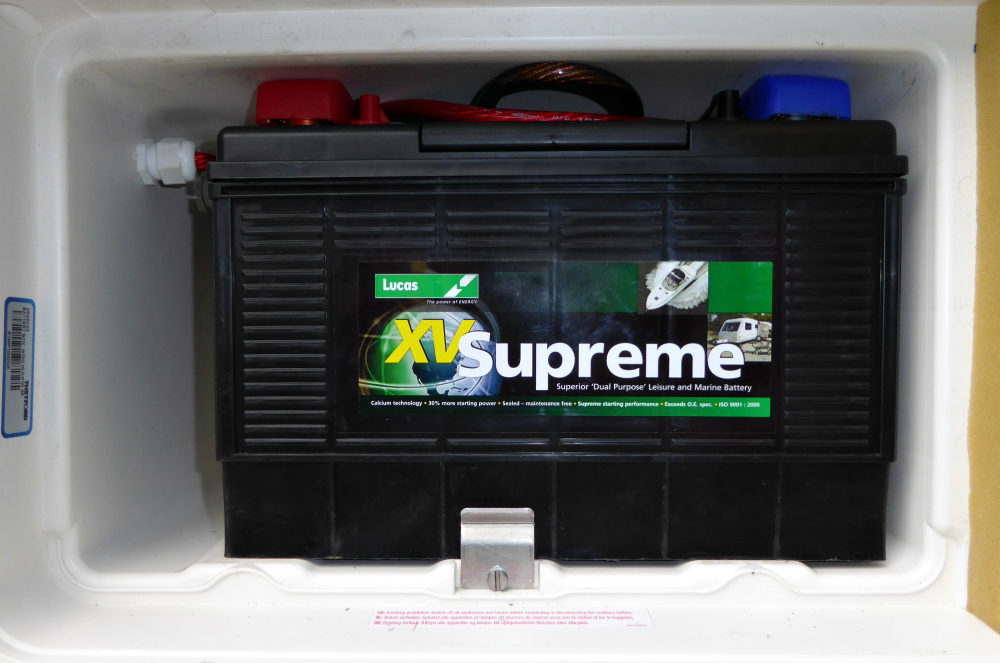
The fix for your leisure battery
There has to be a fix, and there is. The answer is to go back to just two leads, albeit fairly substantial ones, and to take them to a junction box inside the caravan to which all the other leads connect.
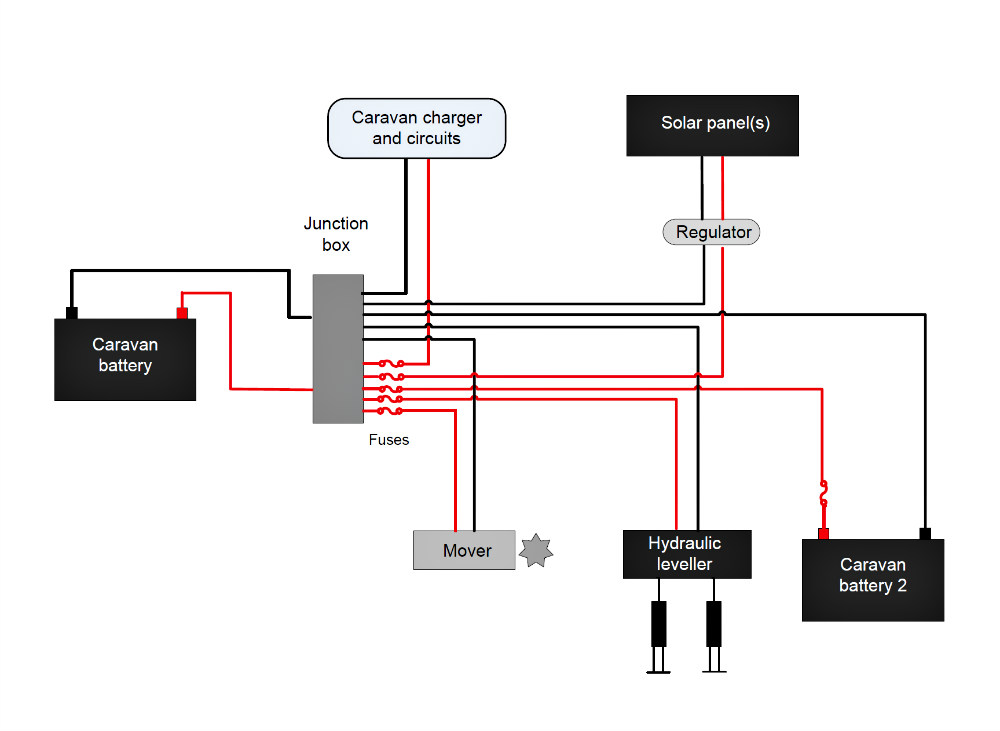
Image above: Wiring diagram
We scoured the internet for a suitable junction box and found that Screwfix sells a five-way double pole unit rated at 100 amps and capable (in theory) of taking wires up to 25 sq mm. Tool Station has something very similar. The cost is around seven pounds.
These junction boxes are intended for use at mains meter positions where there may be a need to feed more than one consumer unit. Being designed for 240 volts, they are more than happy at 12 volts although the phenolic urea construction (think Bakelite) does make them rather brittle. Nevertheless, this material has excellent insulating properties and will take some heat.
We then needed a pair of leads to connect the battery to the junction box. We decided to go for a cross section of at least 20 sq mm as this would give us 100 amp plus capability, especially bearing in mind the very short run to the junction box.
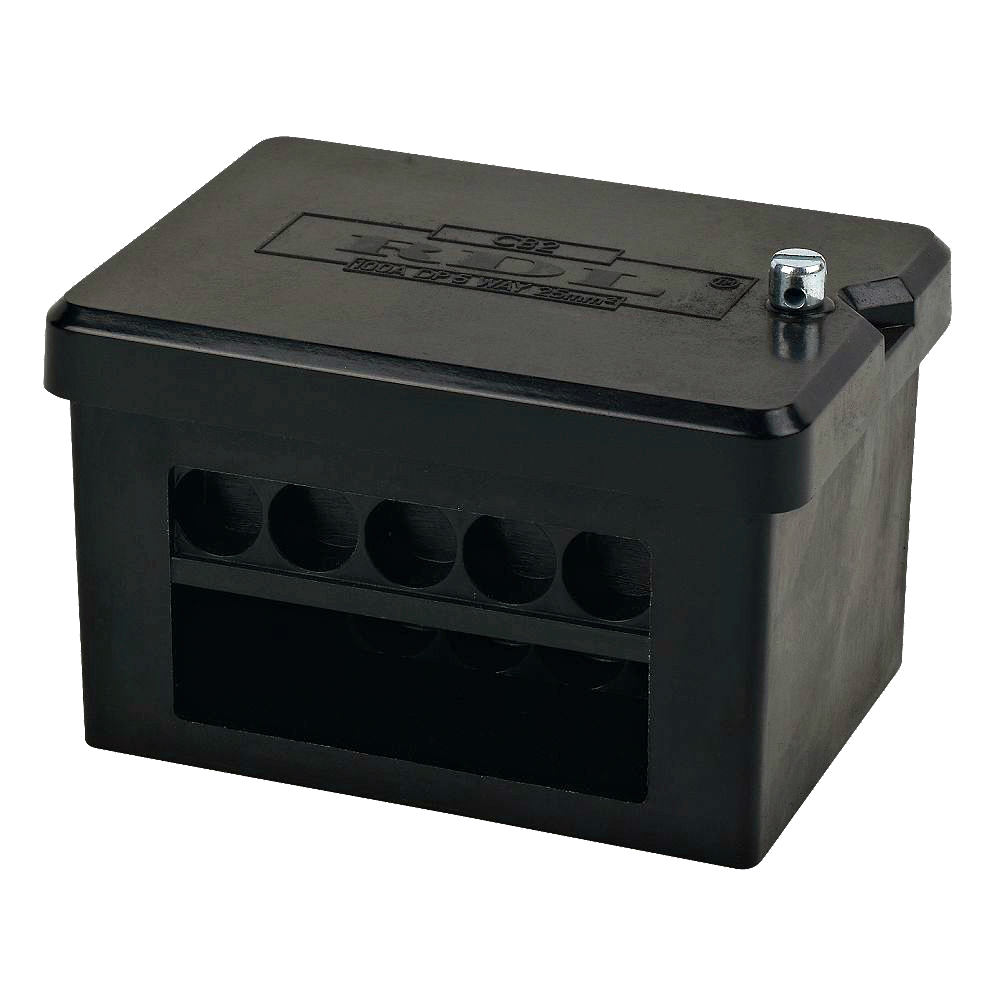
Image above: The five-way junction box available from Screwfix.
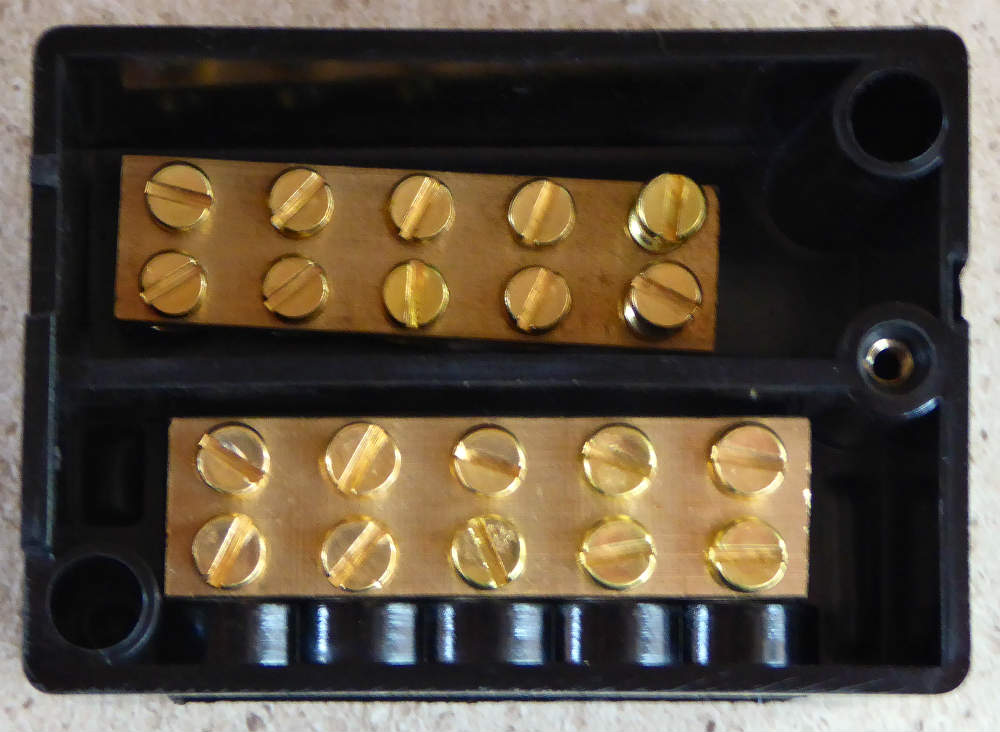
Above: Inside the junction box we used
A quick internet search revealed plenty of options, but we decided to go for Maplin's 'Shark' battery cable at the 4AWG gauge. The size equates to 21.14 sq mm, but the clincher for us was that each cable comprises 1050 strands, making it extremely flexible. The cable is available in red and 'black' (actually brown), and we purchased a metre of each at a total cost of £17.16.
With the mains charger switched off and the battery removed it was time to unscrew the four cable glands and remove all the wires.
We decided to dispense with the two glands at the rear of the box as these prevented taller batteries from being pushed to the back of the box. At best this meant we could not fit the retaining clip and, at worst, we could not close the box. The holes that remained were plugged with rubber grommet stoppers (sourced from Halfords) to prevent battery gases from entering the caravan.
The two existing glands on the left of the box proved perfect for the new cables from Maplins, each one making a good seal.
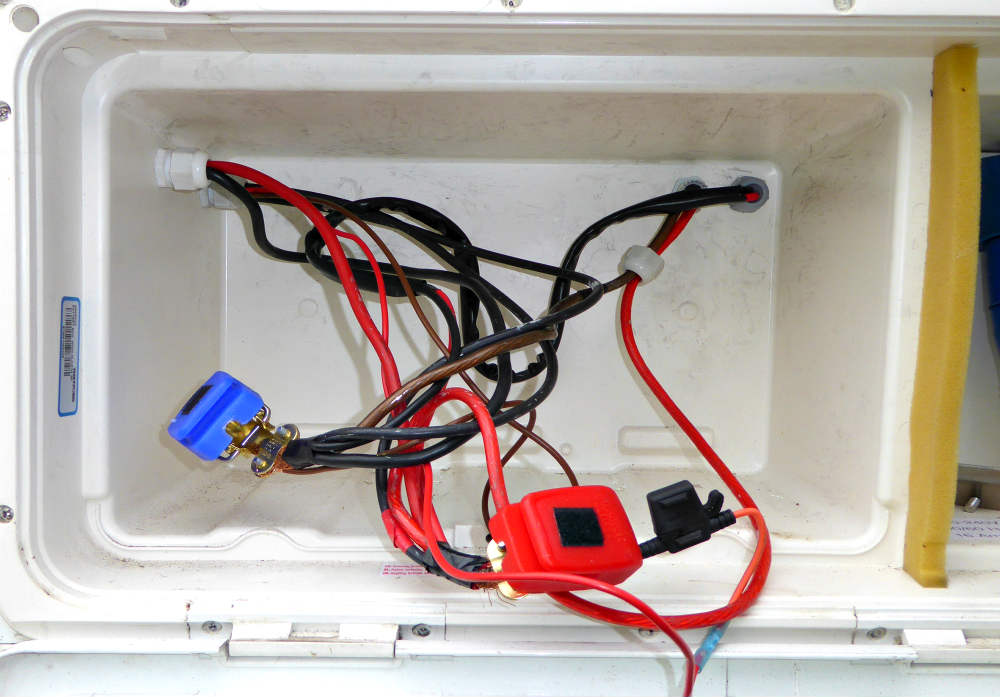
Above: Before
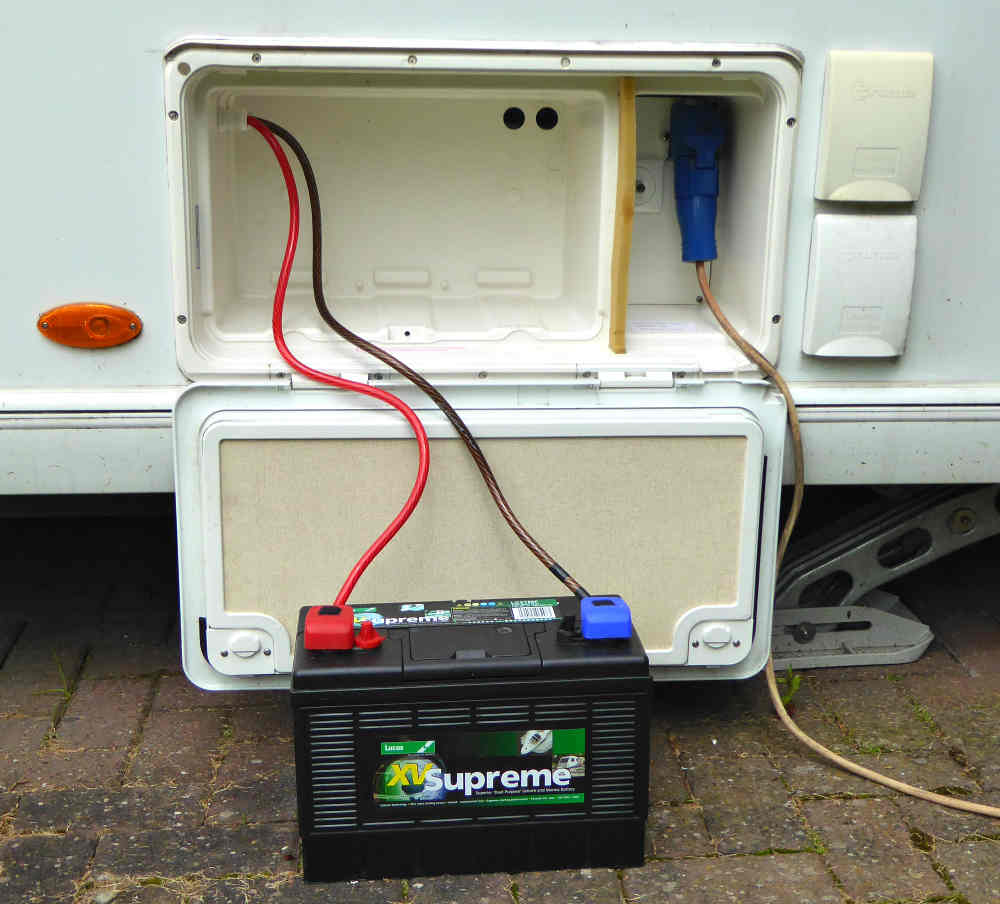
Above: After
We found a convenient spot for the junction box on the floor near the battery box. Then it was just a case of cutting the old wires to length and connecting them to the junction box along with the new ones from Maplins.
The latter proved a tight fit despite the block rating for 25 sq mm cable and ours being 21 sq mm. In the end, we sacrificed a small number of the 1050 strands, but that should have no effect on performance. There is a larger junction box we could have bought that is rated for 35 sq mm cable but overall, ours better suits the other cables.
The eagle-eyed will notice that we had six pairs of wires to connect to our five-way junction box. We resolved this by putting the solar panel and hydraulic leveller wires together into the same connection.
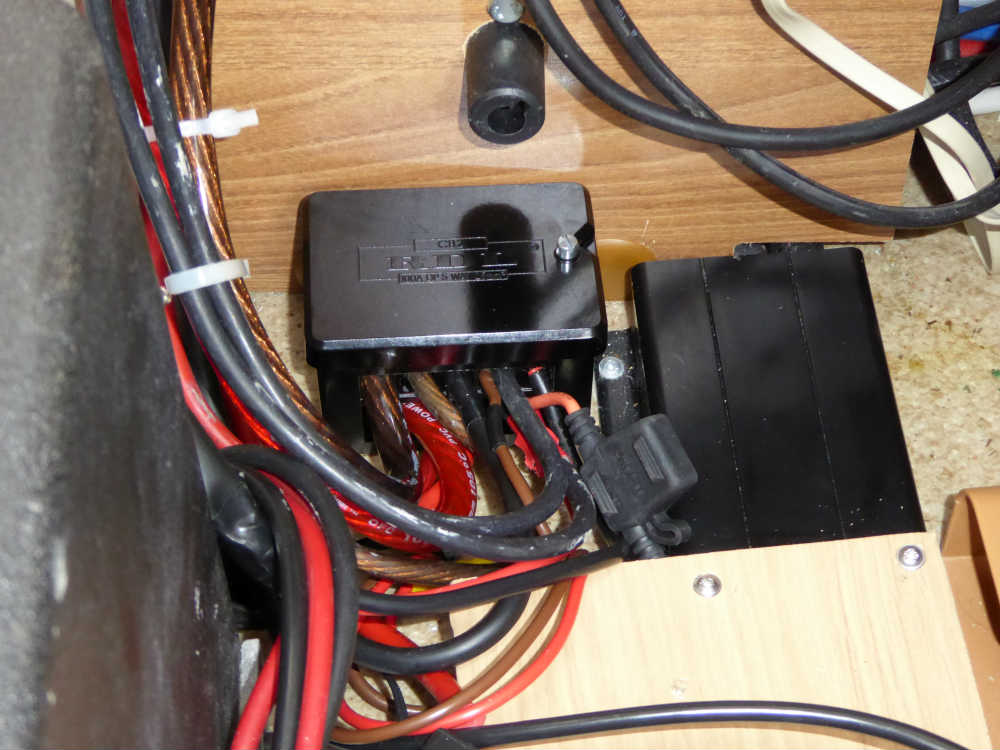
Above: Lots of wires but a neat job
Needless to say, it's crucial to observe the correct polarity throughout. Any mistakes could cause expensive damage to things like mover controllers. We checked and rechecked ours very carefully before going live.
Conclusion
The task is a simple, low-cost job that is easy to do, and well worth it if you have lots of wires going to your battery. Moving the connections to a static block rather than having them on battery terminals eliminates flexing and improves reliability. In our case the extra space we gained enable us to fit a significantly larger battery - perfect for our solar panels and all those loads.








Recent Updates
Caravan showers: all you need to know
In this guide, we’ll discuss the different types of showers, how they work, and how to fit an external shower point to your caravan ...
Caravan towing: all you need to know
Towing a caravan may seem daunting initially, but a few simple tips can make the journey enjoyable and ...
All you need to know about towbars & towballs
Flange, detachable, swan neck, retractable – towbar technology choice is bewildering. Don’t worry. We’ll ...
Caravan WiFi: everything you need to know
Caravan holidays are the ultimate way of getting away from it all, although we sometimes need a link to the ...
Caravan insurance: all you need to know
Navigating the world of caravan insurance can feel like a daunting task. Fear not, as this comprehensive ...
Buying a caravan: what you need to know
Let us guide you through some of the complicated things to think about when first looking at buying a ...
Caravan awnings: a buyers' guide
Caravan awnings are a fantastic addition to any caravan as they are one of the simplest, quickest and most ...
Caravan electrics: avoid tripping out
All caravan owners have overloaded their mains supply at some time. Here’s how to master caravan electrics ...
Caravan heating systems: a quick guide to caravanning warmth
When winter is here, you’ll be glad of a decent caravan heating system if you’re out touring. Here’s how the ...
Caravan damp: a complete guide
There's little more guaranteed to strike fear into the heart of a caravan owner than the word 'damp'. But if ...
Other Articles
Caravan jockey wheels: the definitive guide
A well-functioning caravan jockey wheel can make all the difference to manoeuvring away from the towcar, especially if you don't have a caravan mover ...
Caravan cooking recipes
Caravan cookery inspirational ideas. No need to stress out in the kitchen with these quick and easy ...
Caravan bike racks: a complete guide
Exploring the beautiful surroundings while on a caravan trip is undeniably one of the greatest joys of the ...
A guide to solar power in your caravan
Not that many years ago, mains electrical hook-up on campsites was considered a bit of a luxury, and, for ...
The ultimate guide to caravan layouts
Choosing the right layout or floorplan of your caravan is an all-important part of the buying process – find ...
A guide to seasonal caravan pitches
Our in-depth guide to finding and securing seasonal caravan pitches on your favourite campsite ...
Caravan weights and payloads: a quick guide
The terminology of caravan weight – MIRO, MTPLM, noseweight, kerbweight, payload, weight plate upgrade – is ...
The ultimate guide to caravan motor movers
Caravan motor movers: everything you need to know about remote control caravan manoeuvring ...
Caravan cleaning: All you need to know
Whether you’re taking the caravan out for the first time or it’s just in need of a spruce up, our guide will ...
18 essential items for camping with your dog
Camping is for the whole family – including our four-legged members. Here's what you'll need to keep your dog ...